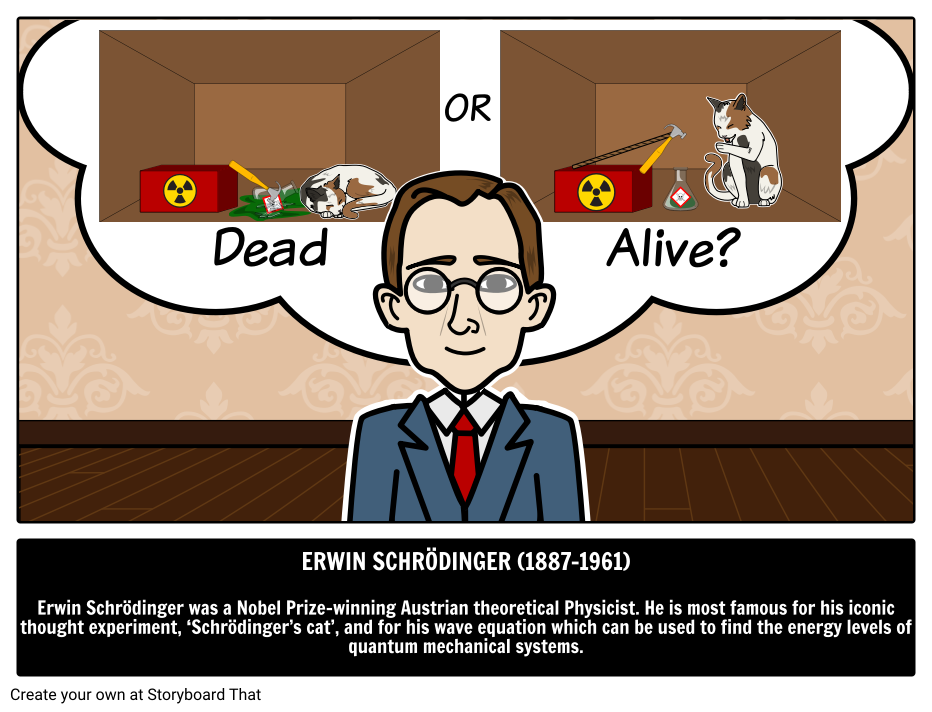Erwin Schrödinger was a Nobel Prize-winning Austrian theoretical physicist. He is most famous for his iconic thought experiment, ‘Schrödinger’s Cat’, and for his wave equation which can be used to find the energy levels of quantum mechanical systems.
Erwin Schrödinger
Schrödinger was born in Vienna, Austria on August 12, 1887. His father was Austrian and his mother was half English so he grew up speaking both German and English at home.
Schrödinger’s most important work was creating a mathematical method that correctly described the energy levels in the Bohr atomic model. Bohr’s theory worked well for hydrogen atoms, but didn’t work so well for more complicated atoms. His groundbreaking wave equation described the movement of electrons by treating them as both particles and waves. It allowed scientists to calculate the energy levels of electrons in more complicated atoms. The wave equation is not the only way to make predictions about quantum mechanical systems, Heisenberg’s matrix mechanics and Feynman’s path integral formulation can also be used.n 1933 Schrödinger Schrödinger won a Nobel Prize for Physics with Paul Dirac for “the discovery of new productive forms of atomic theory”.
In 1935 Schrödinger created a thought experiment known as Schrödinger’s cat. He wrote about it as a discussion point around an article written by Albert Einstein, Boris Podolsky, and Nathan Rosen. This experiment demonstrates a paradox of the Copenhagen interpretation of quantum mechanics. In the experiment a cat is sealed in a metal box. Inside the box is a small amount of radioactive material, an amount so small that in an hour perhaps one atom decays, but with an equal probability that one atom doesn’t decay. Next to this radioactive source is a Geiger counter (a machine used to detect radioactive decay). The Geiger counter is set up so that if it detects a decay a hammer will smash a flask of hydrocyanic acid, which would kill the cat. Schrödinger put forward the idea that after a while the box remains closed, the cat is both dead and alive. It isn’t until we open the box and we observe whether the cat is either alive or dead.
He later became director of the Institute of Advanced study in Dublin and stayed there until he retired in 1956. He then moved back to Vienna. He died aged 73 on January 4, 1961.
Schrödinger’s Significant Accomplishments
- Schrödinger wave equation
- Nobel Prize in physics
- Schrödinger’s cat thought experiment
Erwin Schrödinge Quotes
“The scientist only imposes two things, namely truth and sincerity, imposes them upon himself and upon other scientists.”
“If a man never contradicts himself, the reason must be that he virtually never says anything at all.”
“Consciousness cannot be accounted for in physical terms. For consciousness is absolutely fundamental. It cannot be accounted for in terms of anything else.”
How Tos about Who Was Erwin Schrödinger?
How to Teach Schrödinger's Cat Thought Experiment to Students
Introduce the concept of quantum superposition by asking students to imagine a cat that is both alive and not alive until someone checks. This helps students grasp the counterintuitive nature of quantum mechanics and sets the stage for deeper discussion.
Use Visual Aids to Explain Schrödinger's Cat
Draw or display a simple diagram showing a closed box, a cat, and the possible outcomes. Visuals make abstract ideas more accessible and engage different learning styles in your classroom.
Encourage Student Discussion with Thought-Provoking Questions
Ask students what they think happens to the cat before the box is opened. Open-ended questions foster critical thinking and spark curiosity about science concepts.
Relate Schrödinger's Cat to Real-Life Situations
Give examples of situations where we don't know the outcome until we observe it, like waiting for test results. Connecting to everyday experiences helps students see the relevance of quantum ideas.
Assess Understanding with a Quick Activity
Have students create their own 'mystery box' scenarios and explain what could be inside before opening it. This activity reinforces comprehension and lets you gauge their grasp of the concept.
Frequently Asked Questions about Who Was Erwin Schrödinger?
What is Schrödinger's cat and why is it important in physics?
Schrödinger's cat is a famous thought experiment that illustrates quantum superposition and the uncertainty principle. It shows how a cat can be both alive and dead until observed, highlighting key ideas in quantum mechanics.
Who was Erwin Schrödinger and what did he contribute to science?
Erwin Schrödinger was an Austrian physicist who made major contributions to quantum theory, including the Schrödinger equation and the cat thought experiment, which helped explain the weirdness of quantum states.
How does the Schrödinger equation describe quantum systems?
The Schrödinger equation is a mathematical formula that predicts how quantum particles, like electrons, move and change over time. It is fundamental to understanding how atoms and molecules behave.
Why do teachers use Schrödinger's cat to explain quantum mechanics?
Teachers use Schrödinger's cat because it's a simple and memorable way to show students how quantum particles can exist in multiple states at once, making complex ideas easier to understand.
What are some classroom activities to teach Schrödinger's cat concept?
Classroom activities include role-playing, drawing comic strips, or conducting simple experiments with coins or cards to demonstrate superposition and observation in quantum mechanics.
© 2025 - Clever Prototypes, LLC - All rights reserved.
StoryboardThat is a trademark of Clever Prototypes, LLC, and Registered in U.S. Patent and Trademark Office

